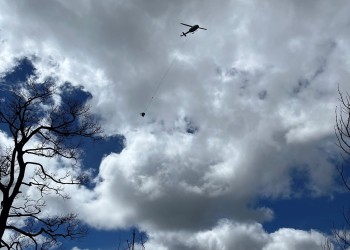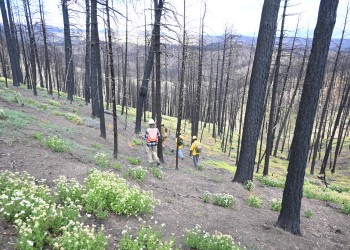Initial Post-Fire Efforts
Back to Post-Fire Restoration Home
After each fire, the Lincoln National Forest quickly began the first phase of its multi-layered recovery strategy. Early efforts focused on stabilizing the land to prevent further damage. Crews seeded burn scars and slopes to reduce erosion, then applied mulch to support vegetation regrowth. Flood-prone areas were cleared of debris, and weed surveys helped identify and control invasive species. Stabilization work also began on historic sites, trails, and roads to protect key infrastructure. Fence materials were secured to begin repairs along damaged boundaries.
Post Fire Seeding and Mulching
In October 2024, the Lincoln National Forest carried out aerial seeding and mulching across the South Fork Burned Area as part of its immediate post-fire rehabilitation strategy. This proven approach, also used in response to incidents like the McBride Burned Area, helps stabilize soil, reduce erosion, and support early ecological recovery. A total of approximately 1,136 acres were seeded to encourage native vegetation regrowth, while 594 acres received mulch treatment to protect vulnerable slopes and improve moisture retention.
Local Lincoln National Forest and Mescalero Apache Tribal crew members tally seeds to verify post fire recovery seed dispersal meets requirements across the South Fork and Salt Burned Area.
(USDA Forest Service photo by Amanda Fry)Post-fire seeding was a vital step in restoring our burned landscapes. By spreading native seed mixes across affected areas, crews helped stabilize soil, reduce erosion, and prevent the spread of invasive species. Native plants are well-adapted to local conditions, support wildlife habitat, and promote long-term ecosystem recovery with minimal maintenance.
The following photos show progress in Perk Canyon over one year. Click the photos for more information.
Post-fire Mulching
The South Fork and Salt Burned Area mulching operation was staged on Mescalero Apache Tribal Lands. This photo shows our crews working together to load and dispersal straw mulch aerially. This technique is used for post fire stabilization.
(USDA Forest Service photo by Amanda Fry)Post-fire mulching is a rapid stabilization technique used to protect burned landscapes from erosion and runoff. For us it involved spreading organic material, straw in our case, over vulnerable soil to reduce rain impact, retain moisture, and support natural regeneration. Applied by aerial methods, mulching was especially important on our steep slopes and waterways as one of the first treatments used to safeguard recovery areas before long-term restoration.
Post-fire mulching and seeding work hand-in-hand to stabilize burned landscapes and jumpstart ecological recovery. Mulching provides immediate ground cover that protects soil from erosion, retains moisture, and reduces runoff, creating a more hospitable environment for seeds to take root. Seeding introduces native vegetation that helps rebuild plant communities, restore habitat, and improve long-term soil health. Together, these treatments reduce the risk of further damage while laying the foundation for resilient regrowth.










